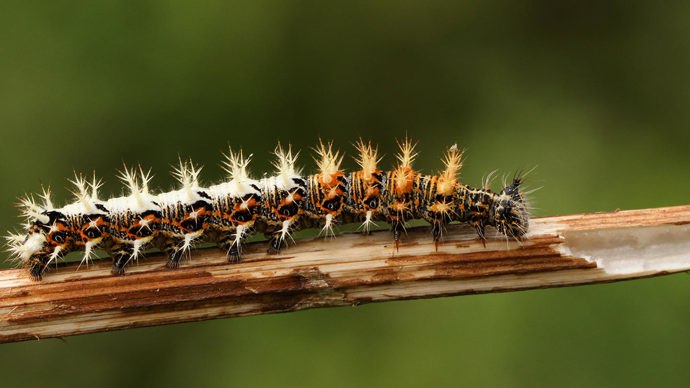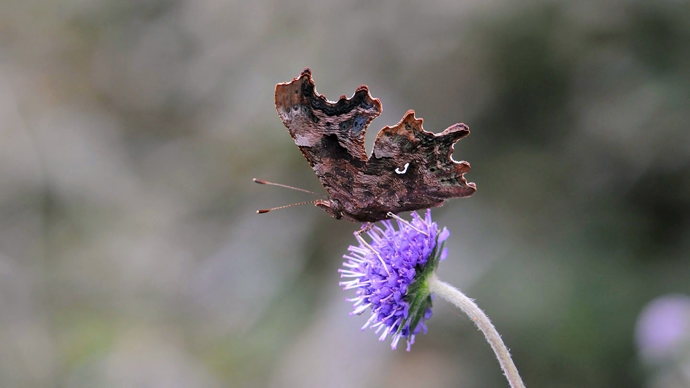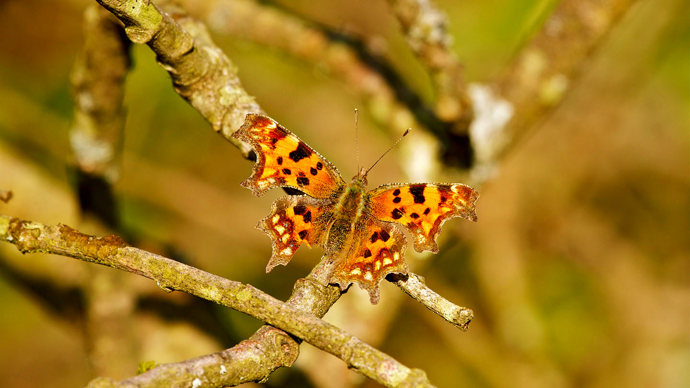Common name: comma
Scientific name: Polygonia c-album
Family: Nymphalidae
Habitat: woodland, gardens
Caterpillar foodplant: stinging nettle
Predators: birds
Origin: native
Tough, charming, rough around the edges. The comma is one of the few butterflies that is becoming more widespread, likely due to global warming.
Common name: comma
Scientific name: Polygonia c-album
Family: Nymphalidae
Habitat: woodland, gardens
Caterpillar foodplant: stinging nettle
Predators: birds
Origin: native
Caterpillars: mainly brown and black with a large white mark along its back towards its rear end. It is also covered in many branched spines.
Adults: orange-brown butterfly with darker markings. It has an unusual wing shape with irregular edges and a distinctive white ‘comma’ shape on the underwing.
Wingspan: 5-6cm.
The caterpillars of the comma are perfectly disguised to look like bird poo!
Caterpillars: stinging nettle is the preferred food, but adults will also lay eggs on species of willow, currant, elm and hops.
Adults: feed on nectar of wild flowers such as thistle and knapweed. They can also be seen feeding on ripe blackberry and fallen fruit such as plums in autumn.

Credit: Sandra Standbridge / Alamy Stock Photo
Female comma butterflies mate with several males to fertilise their eggs. They are able to distinguish between males that have fed on high-quality and low-quality plants and will favour the former. The fertilised female lays her eggs on the leaves of stinging nettles and other larval food plants. The eggs hatch after around five days and the caterpillars will feed on the leaves before undergoing pupation.
The comma hibernates in woodland, usually in hollow trees or log piles. They leave their hibernation spot on warmer winter days and emerge completely in March.

Credit: Andrew Ashworth / WTML
By the mid-1800s the comma was confined to the Welsh Marches, perhaps because of a decline in hop-farming – hops being a favourite food of comma caterpillars. After adapting its preferences to nettles instead its range has expanded. The comma is now found in woodland clearings and gardens throughout England and Wales and has even edged into Scotland. This northward expansion may have been aided by the UK’s warming climate.
When resting with wings closed, the jagged outline makes comma butterflies look like a withered leaf, inconspicuous against wood or foliage.
Commas can be seen at any time of year. They occasionally wake from hibernation on warm winter days, emerging properly in March.
The species loves to bask – whether on a tree trunk, wood-pile or fencepost. If you disturb one staking out its territory along a sunny woodland edge, watch how it invariably flutters back to the same favourite perch to await a likely mate. In late summer you may also find commas feasting on blackberries or fallen plums, fattening up for their winter hibernation.

Credit: Tony Cox / WTML
While the comma was once a rare sight in Britain, it is now the ultimate butterfly success story after having a huge increase in the last 40 years.
It is believed climate change and the increase in temperatures are the reason this butterfly is thriving.